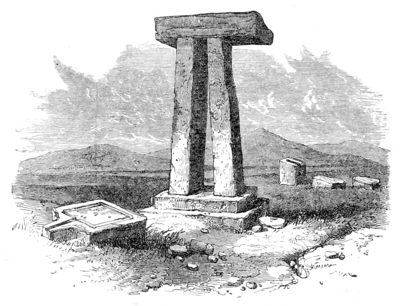and a spout at one side. Whatever this may have been intended for, it is—if the woodcut and description are to be depended upon—the exact counterpart of a Hindu Yoni, and as such would not excite remark as having anything unusual in its appearance if found in a modern temple at Benares. Beyond these in the woodcut are seen several other stones, evidently belonging to the same monument, one of which seems to have been formed into a throne.
These monuments are not, of course, alone. There must be others—probably many others—in the country, a knowledge of which might throw considerable light on our enquiries. In the meanwhile the first thing that strikes one is that Jeffrey of Monmouth's assertion, that "Giants in old days brought from Africa the stones which the magic arts of Merlin afterwards removed from Kildare and set up at Stonehenge,"[1] is not so entirely devoid of foundation as might at first sight appear. The removal of the stones is, of course, absurd, but the suggestion and design may possibly have travelled west by this route.
If we now turn back to page 100, it seems impossible not to
- ↑ 'British History,' viii. chap. ii.

